Determinants of ISO 9000 Adoption & Impact on Firm Performance
VerifiedAdded on 2023/06/11
|32
|7643
|483
Report
AI Summary
This report investigates the operational significance of ISO 9000 and its impact on firm performance, using a speculative model to analyze benefits related to quality management. It explores the determinants of ISO 9000 adoption, considering factors like quality improvement, cost reduction, and innovation, while also addressing the nuances of compliance and the varying adoption patterns across different countries. The study uses statistical and regression analysis on Chinese firms to determine how ISO certification and ownership structure affect firm performance, finding that the positive impact of ISO certification diminishes in firms with ownership issues. Furthermore, the research differentiates the determinants of ISO 9000 certification between manufacturing and service sectors, highlighting the varying importance of factors like quality change, cost reduction, and advancement in these sectors. Ultimately, the findings aim to inform policymakers in effectively applying controls that impact the business success of firms in both manufacturing and service industries.
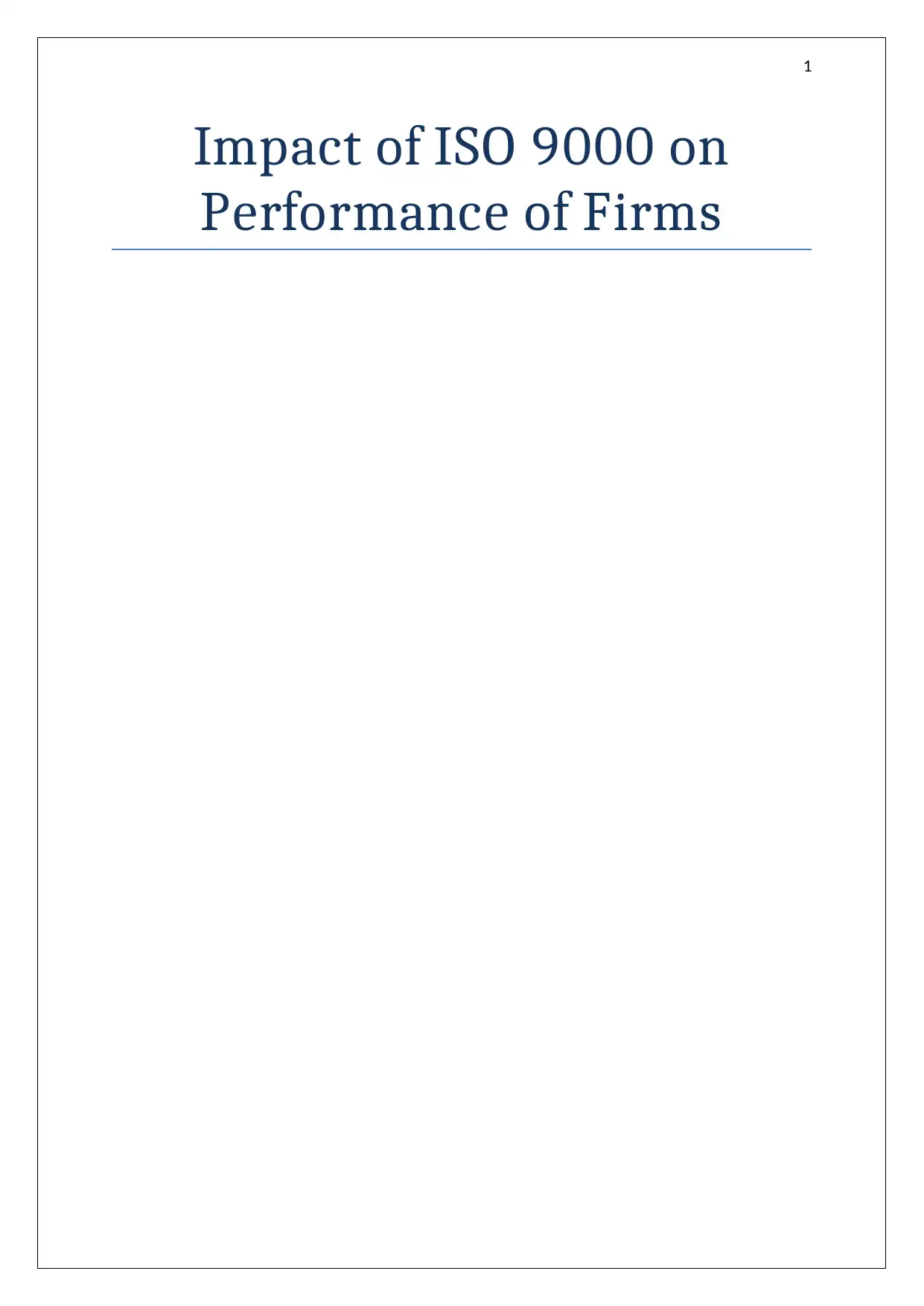
1
Impact of ISO 9000 on
Performance of Firms
Impact of ISO 9000 on
Performance of Firms
Paraphrase This Document
Need a fresh take? Get an instant paraphrase of this document with our AI Paraphraser

2
1.0 Executive Summary
The inspiration driving this paper was to develop the operational significance of ISO 9000, a
speculative model which will investigate the benefits in analyze on quality organization. A
course of action of specific components and sub-factors for tasks of the ISO 9000 compliance
were proposed. Not executing the consistency and getting a charge out of the offices of the
standards rather was an unquestionably essential point, as in past works found in the writing
in various countries, the conclusion was drawn that affiliations don't grasp ISO 9000
homogeneously. The conclusions may be of interest both for insightful and capable circles of
development. Initially, the key parts of a substantive choice of ISO 9000 were included. For
scholastics, certain specific request segments were proposed for a critical form so that these
may be used as a piece of coming works. ISO accreditation has transformed into an inevitable
instrument got by firms to improve their operational execution. In this paper, we take a
gander at the operational and legitimate factors that enhance the likelihood of getting ISO
confirmation and the impact that ISO affirmation and proprietorship structure have upon firm
execution. Regardless, the results demonstrate that the beneficial outcome of ISO
confirmation on execution diminishes in firms where ownership was an issue. One of a kind
survey data on Chinese firms was inspected, regardless of whether there was a qualification
in the determinants of International Organization for Standardization 9000 confirmation
between the vital elements for development and organization portions. Using an exploratory
approach, revelations reveal out that the elements of ISO 9000 affirmation in a general sense
differ among worker and organization elements of the organizations, especially for quality
change, cost diminishment and advancement of these associations. The outcomes of this
examination could enable policy makers to better detail and sufficiently apply controls
impacting the business achievement of firms in both the collecting and organization portions.
Table of Contents
1.0 Executive Summary
The inspiration driving this paper was to develop the operational significance of ISO 9000, a
speculative model which will investigate the benefits in analyze on quality organization. A
course of action of specific components and sub-factors for tasks of the ISO 9000 compliance
were proposed. Not executing the consistency and getting a charge out of the offices of the
standards rather was an unquestionably essential point, as in past works found in the writing
in various countries, the conclusion was drawn that affiliations don't grasp ISO 9000
homogeneously. The conclusions may be of interest both for insightful and capable circles of
development. Initially, the key parts of a substantive choice of ISO 9000 were included. For
scholastics, certain specific request segments were proposed for a critical form so that these
may be used as a piece of coming works. ISO accreditation has transformed into an inevitable
instrument got by firms to improve their operational execution. In this paper, we take a
gander at the operational and legitimate factors that enhance the likelihood of getting ISO
confirmation and the impact that ISO affirmation and proprietorship structure have upon firm
execution. Regardless, the results demonstrate that the beneficial outcome of ISO
confirmation on execution diminishes in firms where ownership was an issue. One of a kind
survey data on Chinese firms was inspected, regardless of whether there was a qualification
in the determinants of International Organization for Standardization 9000 confirmation
between the vital elements for development and organization portions. Using an exploratory
approach, revelations reveal out that the elements of ISO 9000 affirmation in a general sense
differ among worker and organization elements of the organizations, especially for quality
change, cost diminishment and advancement of these associations. The outcomes of this
examination could enable policy makers to better detail and sufficiently apply controls
impacting the business achievement of firms in both the collecting and organization portions.
Table of Contents
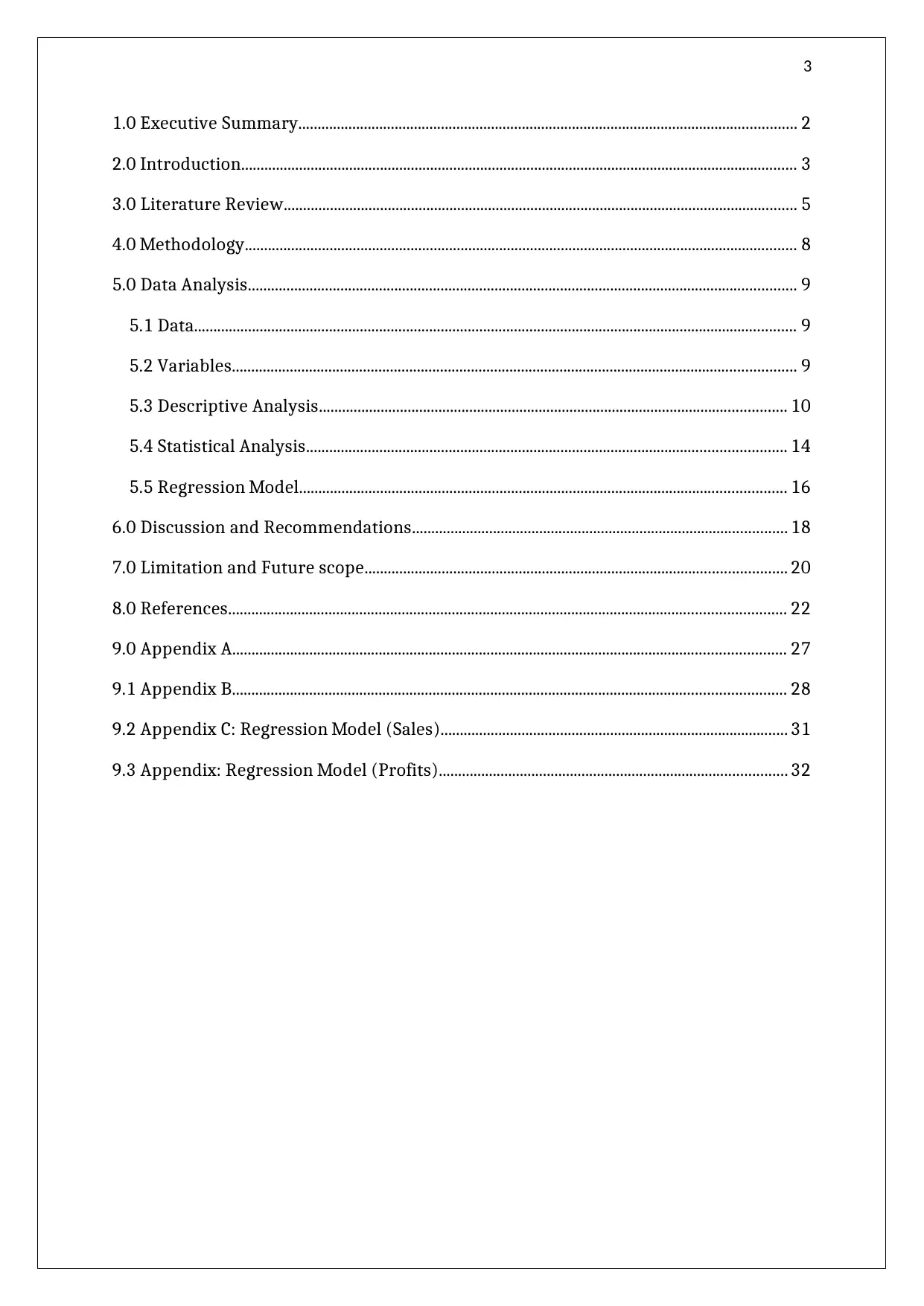
3
1.0 Executive Summary................................................................................................................................. 2
2.0 Introduction................................................................................................................................................ 3
3.0 Literature Review..................................................................................................................................... 5
4.0 Methodology............................................................................................................................................... 8
5.0 Data Analysis.............................................................................................................................................. 9
5.1 Data............................................................................................................................................................ 9
5.2 Variables.................................................................................................................................................. 9
5.3 Descriptive Analysis......................................................................................................................... 10
5.4 Statistical Analysis............................................................................................................................ 14
5.5 Regression Model.............................................................................................................................. 16
6.0 Discussion and Recommendations................................................................................................. 18
7.0 Limitation and Future scope............................................................................................................. 20
8.0 References................................................................................................................................................ 22
9.0 Appendix A............................................................................................................................................... 27
9.1 Appendix B............................................................................................................................................... 28
9.2 Appendix C: Regression Model (Sales).......................................................................................... 31
9.3 Appendix: Regression Model (Profits).......................................................................................... 32
1.0 Executive Summary................................................................................................................................. 2
2.0 Introduction................................................................................................................................................ 3
3.0 Literature Review..................................................................................................................................... 5
4.0 Methodology............................................................................................................................................... 8
5.0 Data Analysis.............................................................................................................................................. 9
5.1 Data............................................................................................................................................................ 9
5.2 Variables.................................................................................................................................................. 9
5.3 Descriptive Analysis......................................................................................................................... 10
5.4 Statistical Analysis............................................................................................................................ 14
5.5 Regression Model.............................................................................................................................. 16
6.0 Discussion and Recommendations................................................................................................. 18
7.0 Limitation and Future scope............................................................................................................. 20
8.0 References................................................................................................................................................ 22
9.0 Appendix A............................................................................................................................................... 27
9.1 Appendix B............................................................................................................................................... 28
9.2 Appendix C: Regression Model (Sales).......................................................................................... 31
9.3 Appendix: Regression Model (Profits).......................................................................................... 32
⊘ This is a preview!⊘
Do you want full access?
Subscribe today to unlock all pages.

Trusted by 1+ million students worldwide
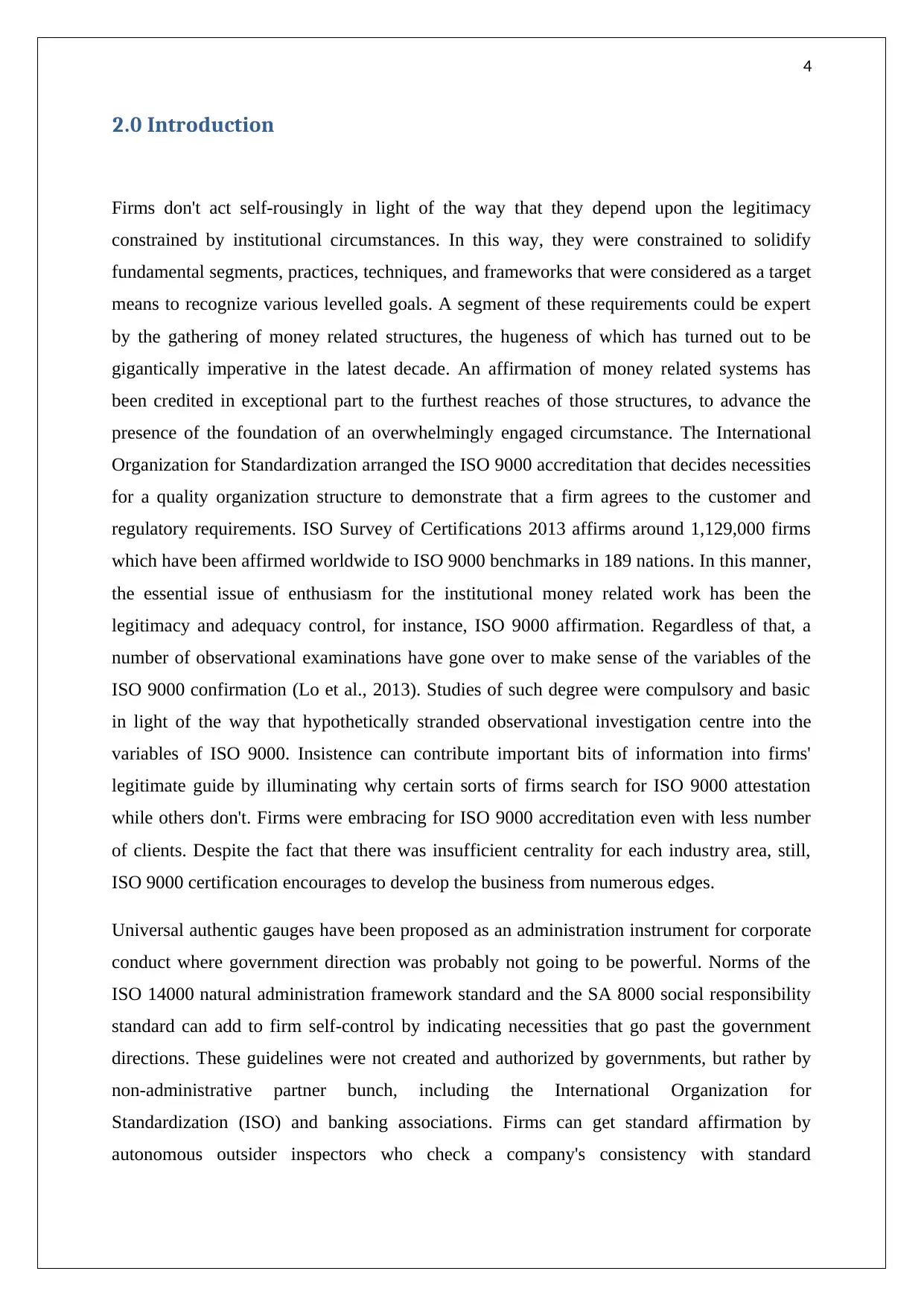
4
2.0 Introduction
Firms don't act self-rousingly in light of the way that they depend upon the legitimacy
constrained by institutional circumstances. In this way, they were constrained to solidify
fundamental segments, practices, techniques, and frameworks that were considered as a target
means to recognize various levelled goals. A segment of these requirements could be expert
by the gathering of money related structures, the hugeness of which has turned out to be
gigantically imperative in the latest decade. An affirmation of money related systems has
been credited in exceptional part to the furthest reaches of those structures, to advance the
presence of the foundation of an overwhelmingly engaged circumstance. The International
Organization for Standardization arranged the ISO 9000 accreditation that decides necessities
for a quality organization structure to demonstrate that a firm agrees to the customer and
regulatory requirements. ISO Survey of Certifications 2013 affirms around 1,129,000 firms
which have been affirmed worldwide to ISO 9000 benchmarks in 189 nations. In this manner,
the essential issue of enthusiasm for the institutional money related work has been the
legitimacy and adequacy control, for instance, ISO 9000 affirmation. Regardless of that, a
number of observational examinations have gone over to make sense of the variables of the
ISO 9000 confirmation (Lo et al., 2013). Studies of such degree were compulsory and basic
in light of the way that hypothetically stranded observational investigation centre into the
variables of ISO 9000. Insistence can contribute important bits of information into firms'
legitimate guide by illuminating why certain sorts of firms search for ISO 9000 attestation
while others don't. Firms were embracing for ISO 9000 accreditation even with less number
of clients. Despite the fact that there was insufficient centrality for each industry area, still,
ISO 9000 certification encourages to develop the business from numerous edges.
Universal authentic gauges have been proposed as an administration instrument for corporate
conduct where government direction was probably not going to be powerful. Norms of the
ISO 14000 natural administration framework standard and the SA 8000 social responsibility
standard can add to firm self-control by indicating necessities that go past the government
directions. These guidelines were not created and authorized by governments, but rather by
non-administrative partner bunch, including the International Organization for
Standardization (ISO) and banking associations. Firms can get standard affirmation by
autonomous outsider inspectors who check a company's consistency with standard
2.0 Introduction
Firms don't act self-rousingly in light of the way that they depend upon the legitimacy
constrained by institutional circumstances. In this way, they were constrained to solidify
fundamental segments, practices, techniques, and frameworks that were considered as a target
means to recognize various levelled goals. A segment of these requirements could be expert
by the gathering of money related structures, the hugeness of which has turned out to be
gigantically imperative in the latest decade. An affirmation of money related systems has
been credited in exceptional part to the furthest reaches of those structures, to advance the
presence of the foundation of an overwhelmingly engaged circumstance. The International
Organization for Standardization arranged the ISO 9000 accreditation that decides necessities
for a quality organization structure to demonstrate that a firm agrees to the customer and
regulatory requirements. ISO Survey of Certifications 2013 affirms around 1,129,000 firms
which have been affirmed worldwide to ISO 9000 benchmarks in 189 nations. In this manner,
the essential issue of enthusiasm for the institutional money related work has been the
legitimacy and adequacy control, for instance, ISO 9000 affirmation. Regardless of that, a
number of observational examinations have gone over to make sense of the variables of the
ISO 9000 confirmation (Lo et al., 2013). Studies of such degree were compulsory and basic
in light of the way that hypothetically stranded observational investigation centre into the
variables of ISO 9000. Insistence can contribute important bits of information into firms'
legitimate guide by illuminating why certain sorts of firms search for ISO 9000 attestation
while others don't. Firms were embracing for ISO 9000 accreditation even with less number
of clients. Despite the fact that there was insufficient centrality for each industry area, still,
ISO 9000 certification encourages to develop the business from numerous edges.
Universal authentic gauges have been proposed as an administration instrument for corporate
conduct where government direction was probably not going to be powerful. Norms of the
ISO 14000 natural administration framework standard and the SA 8000 social responsibility
standard can add to firm self-control by indicating necessities that go past the government
directions. These guidelines were not created and authorized by governments, but rather by
non-administrative partner bunch, including the International Organization for
Standardization (ISO) and banking associations. Firms can get standard affirmation by
autonomous outsider inspectors who check a company's consistency with standard
Paraphrase This Document
Need a fresh take? Get an instant paraphrase of this document with our AI Paraphraser

5
prerequisites. Firms can utilize affirmations in promoting their items. Accordingly, this
administration component depends on the suspicion that organizations will wilfully embrace
these benchmarks since it was useful for business, on the grounds that clients want to buy
items from affirmed providers (Gabriel & Lang, 2015).
For authentic norms to be a compelling administration system for firm self-control, ISO
regulated firms need to agree to the standard's necessities. Most exact research on authentic
models regards confirmation as a double factor estimating the appropriation of the practices
determined by the ISO standard (Drori, Höllerer & Walgenbach, 2014). This accepts that the
demonstration of affirmation was identified with the real execution of the predefined
practises. Inquiries regarding inspector capability, reviewer freedom and the intermittent idea
of reviews raise worries about the adequacy of outsider affirmations (Aravind & Christmann,
2011). It was conceivable that organizations could acquire standard affirmation to show their
responsibility to capable natural direct and working conditions while decoupling accreditation
from genuine practices (Shi Congmei, 2010). Late research has demonstrated that numerous
organizations that do that don't conform to a standard's necessities on a progressing premise
can at present pass occasional reviews for proceeded with confirmation (Boiral & Paillé,
2012). These discoveries question the quality of the connection amongst confirmation and the
execution of the ensured rehearses and the viability of authentic measures as an
administration system.
3.0 Literature Review
Theoretical structure, composing a review and research question point out that disguise of the
ISO 9000 standard includes a dynamic use of concealed practices to change direct and
fundamental initiative (Abe, Bassett & Dempsey, 2012). One of the theoretical structures that
have been progressed in this written work was to look at the interrelationships between ISO
9000 and progress data of the organization. They keep up that organization system. Those
disguised the QM structures (QMS) of ISO 9001 rules; contain unequivocal and undeniable
sorts of embedded data (Martínez-Costa et al., 2009). Information advances toward getting to
be realized when it was deciphered by individuals, given a particular situation, and moored
into the feelings and obligations of individuals (Beitsch, Yeager and Moran, 2015). Cross
sectional analysis of firm’s data was an objective and adjusted learning that addressed the
prerequisites. Firms can utilize affirmations in promoting their items. Accordingly, this
administration component depends on the suspicion that organizations will wilfully embrace
these benchmarks since it was useful for business, on the grounds that clients want to buy
items from affirmed providers (Gabriel & Lang, 2015).
For authentic norms to be a compelling administration system for firm self-control, ISO
regulated firms need to agree to the standard's necessities. Most exact research on authentic
models regards confirmation as a double factor estimating the appropriation of the practices
determined by the ISO standard (Drori, Höllerer & Walgenbach, 2014). This accepts that the
demonstration of affirmation was identified with the real execution of the predefined
practises. Inquiries regarding inspector capability, reviewer freedom and the intermittent idea
of reviews raise worries about the adequacy of outsider affirmations (Aravind & Christmann,
2011). It was conceivable that organizations could acquire standard affirmation to show their
responsibility to capable natural direct and working conditions while decoupling accreditation
from genuine practices (Shi Congmei, 2010). Late research has demonstrated that numerous
organizations that do that don't conform to a standard's necessities on a progressing premise
can at present pass occasional reviews for proceeded with confirmation (Boiral & Paillé,
2012). These discoveries question the quality of the connection amongst confirmation and the
execution of the ensured rehearses and the viability of authentic measures as an
administration system.
3.0 Literature Review
Theoretical structure, composing a review and research question point out that disguise of the
ISO 9000 standard includes a dynamic use of concealed practices to change direct and
fundamental initiative (Abe, Bassett & Dempsey, 2012). One of the theoretical structures that
have been progressed in this written work was to look at the interrelationships between ISO
9000 and progress data of the organization. They keep up that organization system. Those
disguised the QM structures (QMS) of ISO 9001 rules; contain unequivocal and undeniable
sorts of embedded data (Martínez-Costa et al., 2009). Information advances toward getting to
be realized when it was deciphered by individuals, given a particular situation, and moored
into the feelings and obligations of individuals (Beitsch, Yeager and Moran, 2015). Cross
sectional analysis of firm’s data was an objective and adjusted learning that addressed the
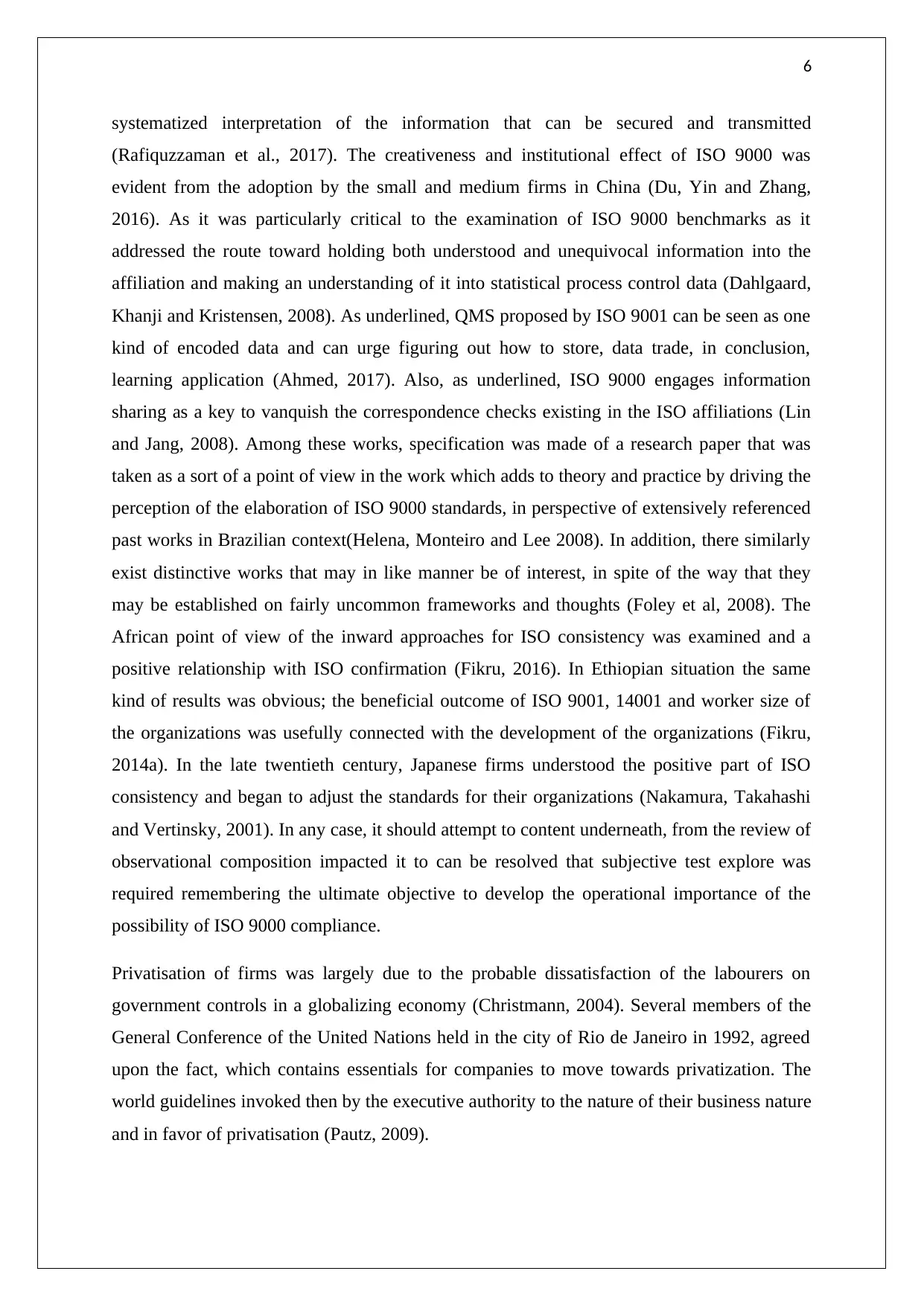
6
systematized interpretation of the information that can be secured and transmitted
(Rafiquzzaman et al., 2017). The creativeness and institutional effect of ISO 9000 was
evident from the adoption by the small and medium firms in China (Du, Yin and Zhang,
2016). As it was particularly critical to the examination of ISO 9000 benchmarks as it
addressed the route toward holding both understood and unequivocal information into the
affiliation and making an understanding of it into statistical process control data (Dahlgaard,
Khanji and Kristensen, 2008). As underlined, QMS proposed by ISO 9001 can be seen as one
kind of encoded data and can urge figuring out how to store, data trade, in conclusion,
learning application (Ahmed, 2017). Also, as underlined, ISO 9000 engages information
sharing as a key to vanquish the correspondence checks existing in the ISO affiliations (Lin
and Jang, 2008). Among these works, specification was made of a research paper that was
taken as a sort of a point of view in the work which adds to theory and practice by driving the
perception of the elaboration of ISO 9000 standards, in perspective of extensively referenced
past works in Brazilian context(Helena, Monteiro and Lee 2008). In addition, there similarly
exist distinctive works that may in like manner be of interest, in spite of the way that they
may be established on fairly uncommon frameworks and thoughts (Foley et al, 2008). The
African point of view of the inward approaches for ISO consistency was examined and a
positive relationship with ISO confirmation (Fikru, 2016). In Ethiopian situation the same
kind of results was obvious; the beneficial outcome of ISO 9001, 14001 and worker size of
the organizations was usefully connected with the development of the organizations (Fikru,
2014a). In the late twentieth century, Japanese firms understood the positive part of ISO
consistency and began to adjust the standards for their organizations (Nakamura, Takahashi
and Vertinsky, 2001). In any case, it should attempt to content underneath, from the review of
observational composition impacted it to can be resolved that subjective test explore was
required remembering the ultimate objective to develop the operational importance of the
possibility of ISO 9000 compliance.
Privatisation of firms was largely due to the probable dissatisfaction of the labourers on
government controls in a globalizing economy (Christmann, 2004). Several members of the
General Conference of the United Nations held in the city of Rio de Janeiro in 1992, agreed
upon the fact, which contains essentials for companies to move towards privatization. The
world guidelines invoked then by the executive authority to the nature of their business nature
and in favor of privatisation (Pautz, 2009).
systematized interpretation of the information that can be secured and transmitted
(Rafiquzzaman et al., 2017). The creativeness and institutional effect of ISO 9000 was
evident from the adoption by the small and medium firms in China (Du, Yin and Zhang,
2016). As it was particularly critical to the examination of ISO 9000 benchmarks as it
addressed the route toward holding both understood and unequivocal information into the
affiliation and making an understanding of it into statistical process control data (Dahlgaard,
Khanji and Kristensen, 2008). As underlined, QMS proposed by ISO 9001 can be seen as one
kind of encoded data and can urge figuring out how to store, data trade, in conclusion,
learning application (Ahmed, 2017). Also, as underlined, ISO 9000 engages information
sharing as a key to vanquish the correspondence checks existing in the ISO affiliations (Lin
and Jang, 2008). Among these works, specification was made of a research paper that was
taken as a sort of a point of view in the work which adds to theory and practice by driving the
perception of the elaboration of ISO 9000 standards, in perspective of extensively referenced
past works in Brazilian context(Helena, Monteiro and Lee 2008). In addition, there similarly
exist distinctive works that may in like manner be of interest, in spite of the way that they
may be established on fairly uncommon frameworks and thoughts (Foley et al, 2008). The
African point of view of the inward approaches for ISO consistency was examined and a
positive relationship with ISO confirmation (Fikru, 2016). In Ethiopian situation the same
kind of results was obvious; the beneficial outcome of ISO 9001, 14001 and worker size of
the organizations was usefully connected with the development of the organizations (Fikru,
2014a). In the late twentieth century, Japanese firms understood the positive part of ISO
consistency and began to adjust the standards for their organizations (Nakamura, Takahashi
and Vertinsky, 2001). In any case, it should attempt to content underneath, from the review of
observational composition impacted it to can be resolved that subjective test explore was
required remembering the ultimate objective to develop the operational importance of the
possibility of ISO 9000 compliance.
Privatisation of firms was largely due to the probable dissatisfaction of the labourers on
government controls in a globalizing economy (Christmann, 2004). Several members of the
General Conference of the United Nations held in the city of Rio de Janeiro in 1992, agreed
upon the fact, which contains essentials for companies to move towards privatization. The
world guidelines invoked then by the executive authority to the nature of their business nature
and in favor of privatisation (Pautz, 2009).
⊘ This is a preview!⊘
Do you want full access?
Subscribe today to unlock all pages.

Trusted by 1+ million students worldwide
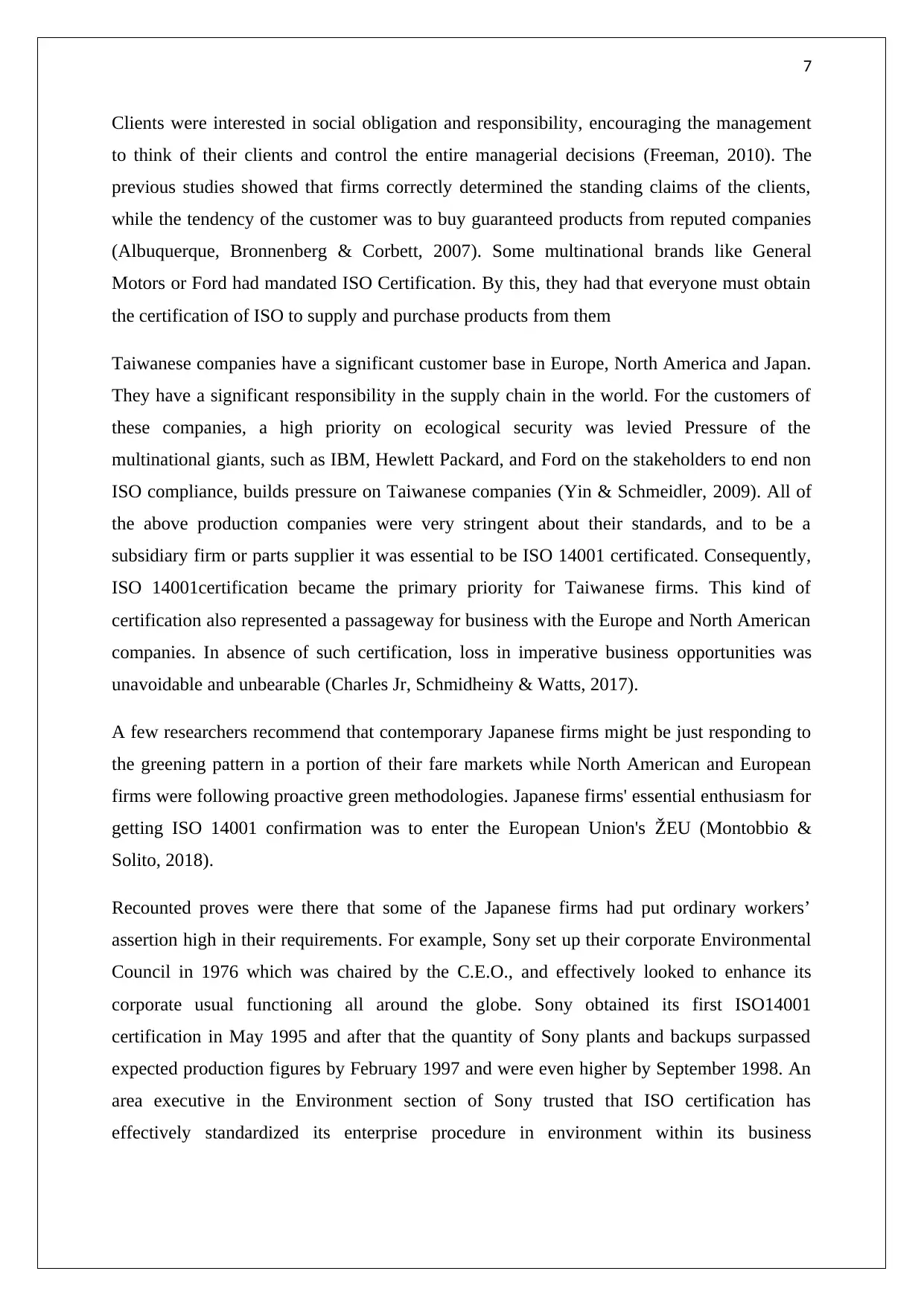
7
Clients were interested in social obligation and responsibility, encouraging the management
to think of their clients and control the entire managerial decisions (Freeman, 2010). The
previous studies showed that firms correctly determined the standing claims of the clients,
while the tendency of the customer was to buy guaranteed products from reputed companies
(Albuquerque, Bronnenberg & Corbett, 2007). Some multinational brands like General
Motors or Ford had mandated ISO Certification. By this, they had that everyone must obtain
the certification of ISO to supply and purchase products from them
Taiwanese companies have a significant customer base in Europe, North America and Japan.
They have a significant responsibility in the supply chain in the world. For the customers of
these companies, a high priority on ecological security was levied Pressure of the
multinational giants, such as IBM, Hewlett Packard, and Ford on the stakeholders to end non
ISO compliance, builds pressure on Taiwanese companies (Yin & Schmeidler, 2009). All of
the above production companies were very stringent about their standards, and to be a
subsidiary firm or parts supplier it was essential to be ISO 14001 certificated. Consequently,
ISO 14001certification became the primary priority for Taiwanese firms. This kind of
certification also represented a passageway for business with the Europe and North American
companies. In absence of such certification, loss in imperative business opportunities was
unavoidable and unbearable (Charles Jr, Schmidheiny & Watts, 2017).
A few researchers recommend that contemporary Japanese firms might be just responding to
the greening pattern in a portion of their fare markets while North American and European
firms were following proactive green methodologies. Japanese firms' essential enthusiasm for
getting ISO 14001 confirmation was to enter the European Union's ŽEU (Montobbio &
Solito, 2018).
Recounted proves were there that some of the Japanese firms had put ordinary workers’
assertion high in their requirements. For example, Sony set up their corporate Environmental
Council in 1976 which was chaired by the C.E.O., and effectively looked to enhance its
corporate usual functioning all around the globe. Sony obtained its first ISO14001
certification in May 1995 and after that the quantity of Sony plants and backups surpassed
expected production figures by February 1997 and were even higher by September 1998. An
area executive in the Environment section of Sony trusted that ISO certification has
effectively standardized its enterprise procedure in environment within its business
Clients were interested in social obligation and responsibility, encouraging the management
to think of their clients and control the entire managerial decisions (Freeman, 2010). The
previous studies showed that firms correctly determined the standing claims of the clients,
while the tendency of the customer was to buy guaranteed products from reputed companies
(Albuquerque, Bronnenberg & Corbett, 2007). Some multinational brands like General
Motors or Ford had mandated ISO Certification. By this, they had that everyone must obtain
the certification of ISO to supply and purchase products from them
Taiwanese companies have a significant customer base in Europe, North America and Japan.
They have a significant responsibility in the supply chain in the world. For the customers of
these companies, a high priority on ecological security was levied Pressure of the
multinational giants, such as IBM, Hewlett Packard, and Ford on the stakeholders to end non
ISO compliance, builds pressure on Taiwanese companies (Yin & Schmeidler, 2009). All of
the above production companies were very stringent about their standards, and to be a
subsidiary firm or parts supplier it was essential to be ISO 14001 certificated. Consequently,
ISO 14001certification became the primary priority for Taiwanese firms. This kind of
certification also represented a passageway for business with the Europe and North American
companies. In absence of such certification, loss in imperative business opportunities was
unavoidable and unbearable (Charles Jr, Schmidheiny & Watts, 2017).
A few researchers recommend that contemporary Japanese firms might be just responding to
the greening pattern in a portion of their fare markets while North American and European
firms were following proactive green methodologies. Japanese firms' essential enthusiasm for
getting ISO 14001 confirmation was to enter the European Union's ŽEU (Montobbio &
Solito, 2018).
Recounted proves were there that some of the Japanese firms had put ordinary workers’
assertion high in their requirements. For example, Sony set up their corporate Environmental
Council in 1976 which was chaired by the C.E.O., and effectively looked to enhance its
corporate usual functioning all around the globe. Sony obtained its first ISO14001
certification in May 1995 and after that the quantity of Sony plants and backups surpassed
expected production figures by February 1997 and were even higher by September 1998. An
area executive in the Environment section of Sony trusted that ISO certification has
effectively standardized its enterprise procedure in environment within its business
Paraphrase This Document
Need a fresh take? Get an instant paraphrase of this document with our AI Paraphraser
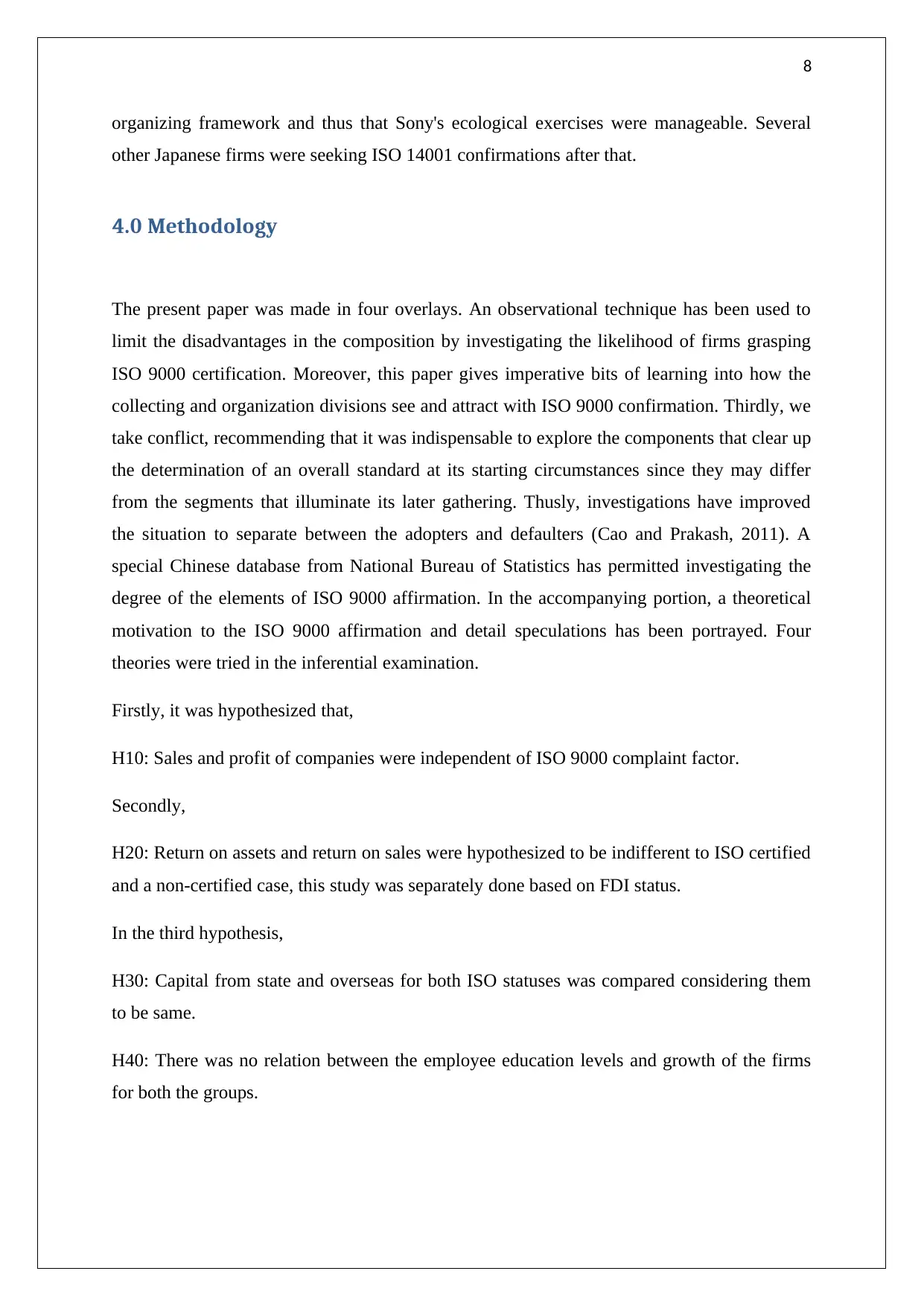
8
organizing framework and thus that Sony's ecological exercises were manageable. Several
other Japanese firms were seeking ISO 14001 confirmations after that.
4.0 Methodology
The present paper was made in four overlays. An observational technique has been used to
limit the disadvantages in the composition by investigating the likelihood of firms grasping
ISO 9000 certification. Moreover, this paper gives imperative bits of learning into how the
collecting and organization divisions see and attract with ISO 9000 confirmation. Thirdly, we
take conflict, recommending that it was indispensable to explore the components that clear up
the determination of an overall standard at its starting circumstances since they may differ
from the segments that illuminate its later gathering. Thusly, investigations have improved
the situation to separate between the adopters and defaulters (Cao and Prakash, 2011). A
special Chinese database from National Bureau of Statistics has permitted investigating the
degree of the elements of ISO 9000 affirmation. In the accompanying portion, a theoretical
motivation to the ISO 9000 affirmation and detail speculations has been portrayed. Four
theories were tried in the inferential examination.
Firstly, it was hypothesized that,
H10: Sales and profit of companies were independent of ISO 9000 complaint factor.
Secondly,
H20: Return on assets and return on sales were hypothesized to be indifferent to ISO certified
and a non-certified case, this study was separately done based on FDI status.
In the third hypothesis,
H30: Capital from state and overseas for both ISO statuses was compared considering them
to be same.
H40: There was no relation between the employee education levels and growth of the firms
for both the groups.
organizing framework and thus that Sony's ecological exercises were manageable. Several
other Japanese firms were seeking ISO 14001 confirmations after that.
4.0 Methodology
The present paper was made in four overlays. An observational technique has been used to
limit the disadvantages in the composition by investigating the likelihood of firms grasping
ISO 9000 certification. Moreover, this paper gives imperative bits of learning into how the
collecting and organization divisions see and attract with ISO 9000 confirmation. Thirdly, we
take conflict, recommending that it was indispensable to explore the components that clear up
the determination of an overall standard at its starting circumstances since they may differ
from the segments that illuminate its later gathering. Thusly, investigations have improved
the situation to separate between the adopters and defaulters (Cao and Prakash, 2011). A
special Chinese database from National Bureau of Statistics has permitted investigating the
degree of the elements of ISO 9000 affirmation. In the accompanying portion, a theoretical
motivation to the ISO 9000 affirmation and detail speculations has been portrayed. Four
theories were tried in the inferential examination.
Firstly, it was hypothesized that,
H10: Sales and profit of companies were independent of ISO 9000 complaint factor.
Secondly,
H20: Return on assets and return on sales were hypothesized to be indifferent to ISO certified
and a non-certified case, this study was separately done based on FDI status.
In the third hypothesis,
H30: Capital from state and overseas for both ISO statuses was compared considering them
to be same.
H40: There was no relation between the employee education levels and growth of the firms
for both the groups.
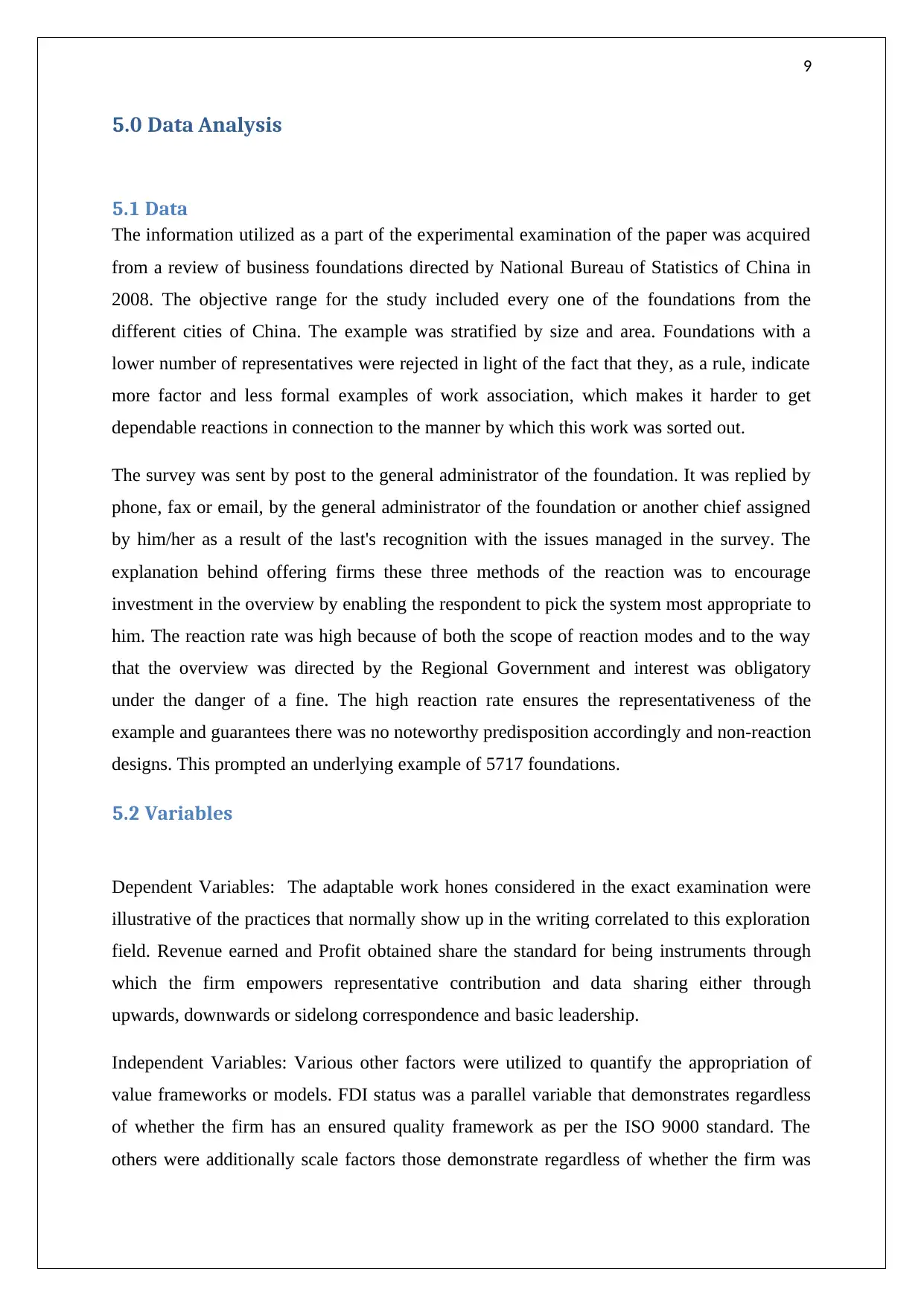
9
5.0 Data Analysis
5.1 Data
The information utilized as a part of the experimental examination of the paper was acquired
from a review of business foundations directed by National Bureau of Statistics of China in
2008. The objective range for the study included every one of the foundations from the
different cities of China. The example was stratified by size and area. Foundations with a
lower number of representatives were rejected in light of the fact that they, as a rule, indicate
more factor and less formal examples of work association, which makes it harder to get
dependable reactions in connection to the manner by which this work was sorted out.
The survey was sent by post to the general administrator of the foundation. It was replied by
phone, fax or email, by the general administrator of the foundation or another chief assigned
by him/her as a result of the last's recognition with the issues managed in the survey. The
explanation behind offering firms these three methods of the reaction was to encourage
investment in the overview by enabling the respondent to pick the system most appropriate to
him. The reaction rate was high because of both the scope of reaction modes and to the way
that the overview was directed by the Regional Government and interest was obligatory
under the danger of a fine. The high reaction rate ensures the representativeness of the
example and guarantees there was no noteworthy predisposition accordingly and non-reaction
designs. This prompted an underlying example of 5717 foundations.
5.2 Variables
Dependent Variables: The adaptable work hones considered in the exact examination were
illustrative of the practices that normally show up in the writing correlated to this exploration
field. Revenue earned and Profit obtained share the standard for being instruments through
which the firm empowers representative contribution and data sharing either through
upwards, downwards or sidelong correspondence and basic leadership.
Independent Variables: Various other factors were utilized to quantify the appropriation of
value frameworks or models. FDI status was a parallel variable that demonstrates regardless
of whether the firm has an ensured quality framework as per the ISO 9000 standard. The
others were additionally scale factors those demonstrate regardless of whether the firm was
5.0 Data Analysis
5.1 Data
The information utilized as a part of the experimental examination of the paper was acquired
from a review of business foundations directed by National Bureau of Statistics of China in
2008. The objective range for the study included every one of the foundations from the
different cities of China. The example was stratified by size and area. Foundations with a
lower number of representatives were rejected in light of the fact that they, as a rule, indicate
more factor and less formal examples of work association, which makes it harder to get
dependable reactions in connection to the manner by which this work was sorted out.
The survey was sent by post to the general administrator of the foundation. It was replied by
phone, fax or email, by the general administrator of the foundation or another chief assigned
by him/her as a result of the last's recognition with the issues managed in the survey. The
explanation behind offering firms these three methods of the reaction was to encourage
investment in the overview by enabling the respondent to pick the system most appropriate to
him. The reaction rate was high because of both the scope of reaction modes and to the way
that the overview was directed by the Regional Government and interest was obligatory
under the danger of a fine. The high reaction rate ensures the representativeness of the
example and guarantees there was no noteworthy predisposition accordingly and non-reaction
designs. This prompted an underlying example of 5717 foundations.
5.2 Variables
Dependent Variables: The adaptable work hones considered in the exact examination were
illustrative of the practices that normally show up in the writing correlated to this exploration
field. Revenue earned and Profit obtained share the standard for being instruments through
which the firm empowers representative contribution and data sharing either through
upwards, downwards or sidelong correspondence and basic leadership.
Independent Variables: Various other factors were utilized to quantify the appropriation of
value frameworks or models. FDI status was a parallel variable that demonstrates regardless
of whether the firm has an ensured quality framework as per the ISO 9000 standard. The
others were additionally scale factors those demonstrate regardless of whether the firm was
⊘ This is a preview!⊘
Do you want full access?
Subscribe today to unlock all pages.

Trusted by 1+ million students worldwide

10
engaged with the assessment procedure as indicated by the EFQM demonstrate, as an
approach to guarantee that the firm was successfully working in such a structure.
5.3 Descriptive Analysis
A total of 5717 organization information were accessible, where 460 organizations were ISO
9000 enrolled and rest of 5257 organizations were non-ISO 9000 organizations. The normal
and standard deviation of the considerable number of factors (scale variable) has been given
in table 1 and table 2, in light of ISO 9000 compliance and non-assertion organizations.
Income and offers of the organizations were taken as needy factors in the exploration work.
For ISO certified firms (N = 460), average sales and profits were $ 29591.67 (SD =
$ 55356.92) and $ 4384.67 (SD = $ 9237.04). For non-ISO certified firms, average sales and
profits were $ 10132.88 (SD = $ 29617.09) and $ 1865.26 (SD = $ 6911.27).
Table 1: Variables and Descriptive Statistics for Non-ISO Certified Companies
Descriptive for Not ISO 9000 certified Companies
Variable Mean Std. Deviation
master and doctor 1.1 4.71
bachelor 9.49 23.27
diploma 11.34 20.95
high school 11.63 28.71
other 6.54 25.92
sales 10132.88 29617.09
profit 1865.26 6911.27
asset 14981.12 53574.92
equity 6899.36 30642.06
capital paid 4371.79 16971.71
capital from state 1138.29 11427.34
capital from
overseas 329.61 4650.86
capital from other 2903.9 11278.13
return on sales 0.19 0.12
return on asset 0.23 0.21
engaged with the assessment procedure as indicated by the EFQM demonstrate, as an
approach to guarantee that the firm was successfully working in such a structure.
5.3 Descriptive Analysis
A total of 5717 organization information were accessible, where 460 organizations were ISO
9000 enrolled and rest of 5257 organizations were non-ISO 9000 organizations. The normal
and standard deviation of the considerable number of factors (scale variable) has been given
in table 1 and table 2, in light of ISO 9000 compliance and non-assertion organizations.
Income and offers of the organizations were taken as needy factors in the exploration work.
For ISO certified firms (N = 460), average sales and profits were $ 29591.67 (SD =
$ 55356.92) and $ 4384.67 (SD = $ 9237.04). For non-ISO certified firms, average sales and
profits were $ 10132.88 (SD = $ 29617.09) and $ 1865.26 (SD = $ 6911.27).
Table 1: Variables and Descriptive Statistics for Non-ISO Certified Companies
Descriptive for Not ISO 9000 certified Companies
Variable Mean Std. Deviation
master and doctor 1.1 4.71
bachelor 9.49 23.27
diploma 11.34 20.95
high school 11.63 28.71
other 6.54 25.92
sales 10132.88 29617.09
profit 1865.26 6911.27
asset 14981.12 53574.92
equity 6899.36 30642.06
capital paid 4371.79 16971.71
capital from state 1138.29 11427.34
capital from
overseas 329.61 4650.86
capital from other 2903.9 11278.13
return on sales 0.19 0.12
return on asset 0.23 0.21
Paraphrase This Document
Need a fresh take? Get an instant paraphrase of this document with our AI Paraphraser
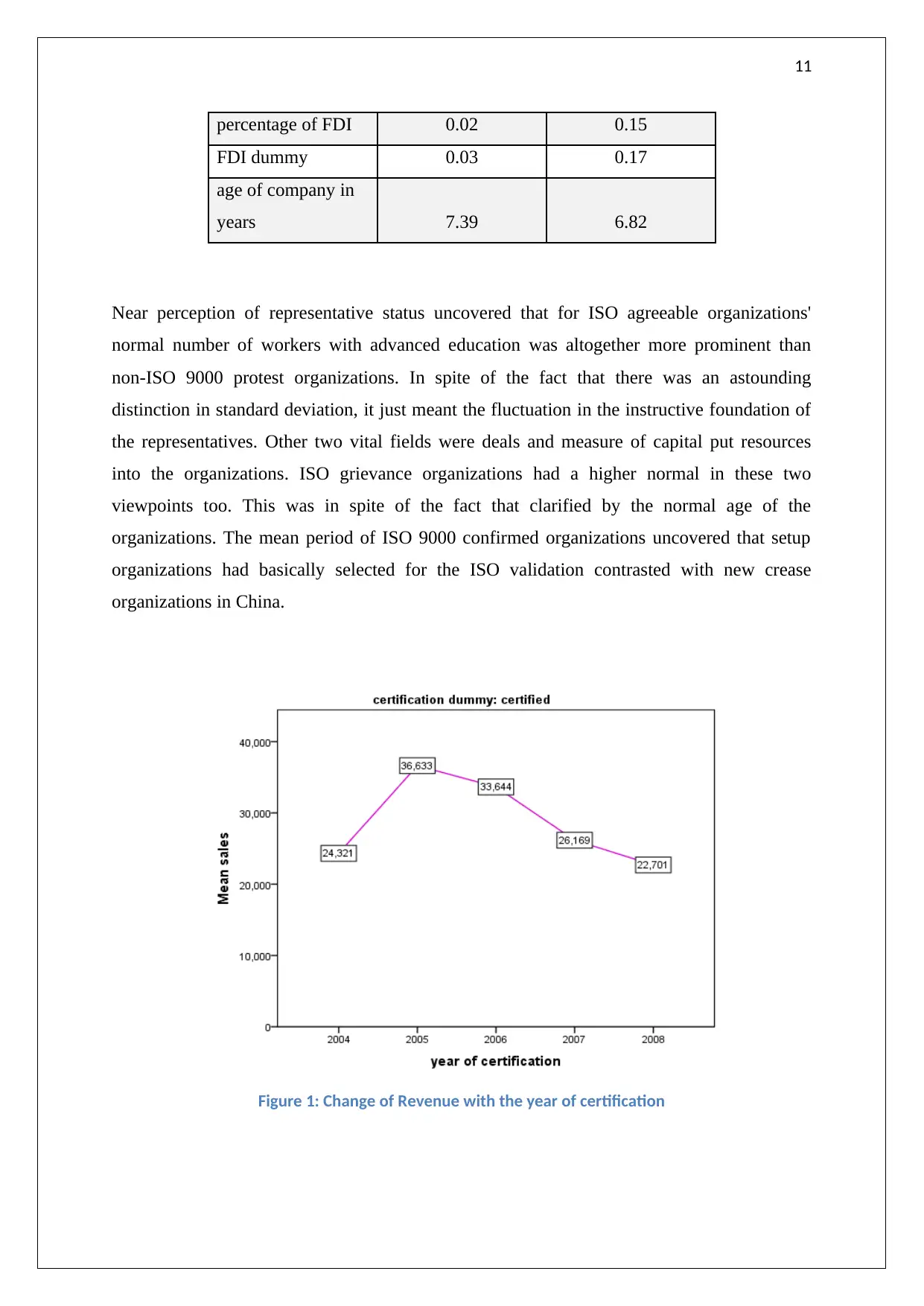
11
percentage of FDI 0.02 0.15
FDI dummy 0.03 0.17
age of company in
years 7.39 6.82
Near perception of representative status uncovered that for ISO agreeable organizations'
normal number of workers with advanced education was altogether more prominent than
non-ISO 9000 protest organizations. In spite of the fact that there was an astounding
distinction in standard deviation, it just meant the fluctuation in the instructive foundation of
the representatives. Other two vital fields were deals and measure of capital put resources
into the organizations. ISO grievance organizations had a higher normal in these two
viewpoints too. This was in spite of the fact that clarified by the normal age of the
organizations. The mean period of ISO 9000 confirmed organizations uncovered that setup
organizations had basically selected for the ISO validation contrasted with new crease
organizations in China.
Figure 1: Change of Revenue with the year of certification
percentage of FDI 0.02 0.15
FDI dummy 0.03 0.17
age of company in
years 7.39 6.82
Near perception of representative status uncovered that for ISO agreeable organizations'
normal number of workers with advanced education was altogether more prominent than
non-ISO 9000 protest organizations. In spite of the fact that there was an astounding
distinction in standard deviation, it just meant the fluctuation in the instructive foundation of
the representatives. Other two vital fields were deals and measure of capital put resources
into the organizations. ISO grievance organizations had a higher normal in these two
viewpoints too. This was in spite of the fact that clarified by the normal age of the
organizations. The mean period of ISO 9000 confirmed organizations uncovered that setup
organizations had basically selected for the ISO validation contrasted with new crease
organizations in China.
Figure 1: Change of Revenue with the year of certification
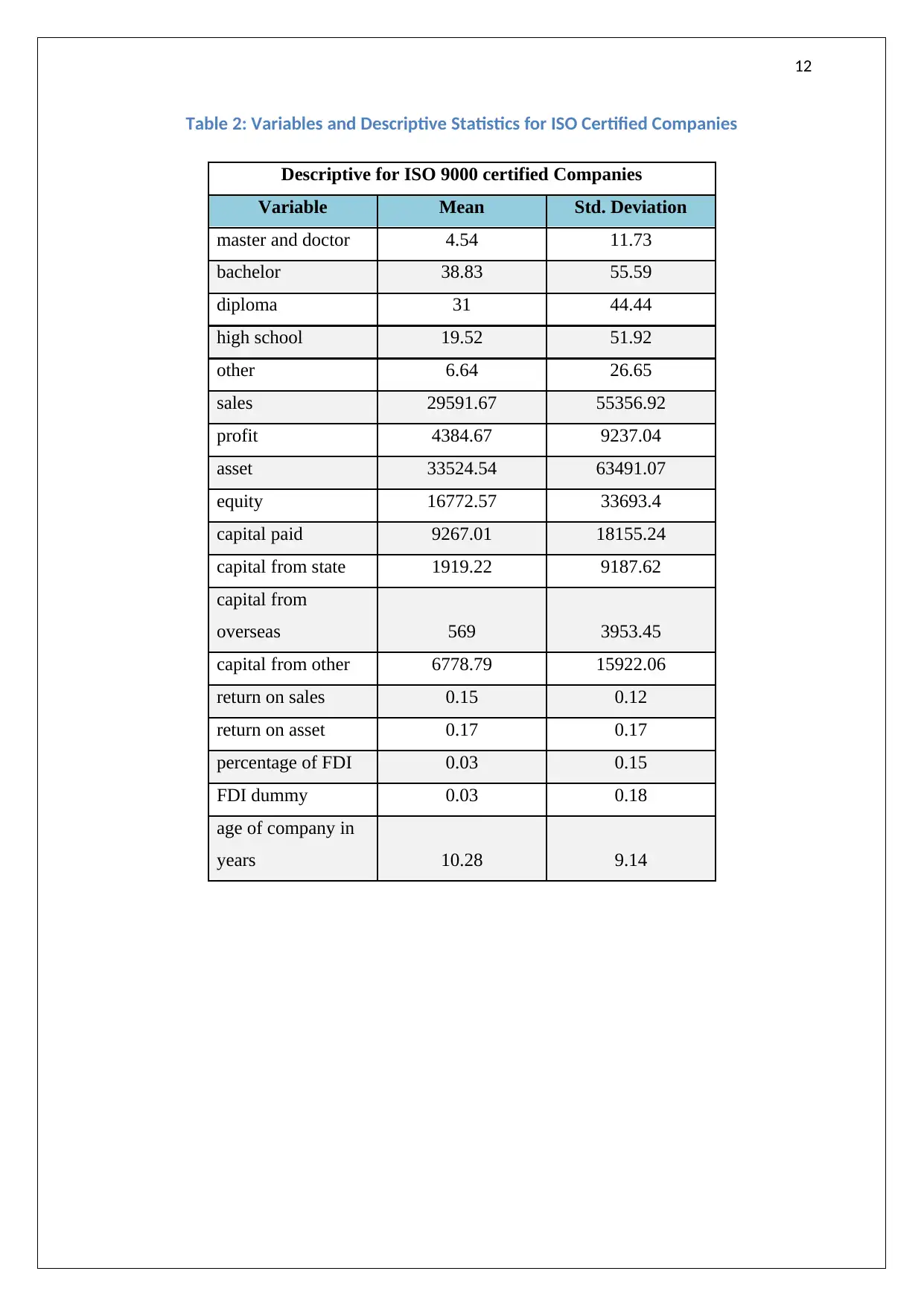
12
Table 2: Variables and Descriptive Statistics for ISO Certified Companies
Descriptive for ISO 9000 certified Companies
Variable Mean Std. Deviation
master and doctor 4.54 11.73
bachelor 38.83 55.59
diploma 31 44.44
high school 19.52 51.92
other 6.64 26.65
sales 29591.67 55356.92
profit 4384.67 9237.04
asset 33524.54 63491.07
equity 16772.57 33693.4
capital paid 9267.01 18155.24
capital from state 1919.22 9187.62
capital from
overseas 569 3953.45
capital from other 6778.79 15922.06
return on sales 0.15 0.12
return on asset 0.17 0.17
percentage of FDI 0.03 0.15
FDI dummy 0.03 0.18
age of company in
years 10.28 9.14
Table 2: Variables and Descriptive Statistics for ISO Certified Companies
Descriptive for ISO 9000 certified Companies
Variable Mean Std. Deviation
master and doctor 4.54 11.73
bachelor 38.83 55.59
diploma 31 44.44
high school 19.52 51.92
other 6.64 26.65
sales 29591.67 55356.92
profit 4384.67 9237.04
asset 33524.54 63491.07
equity 16772.57 33693.4
capital paid 9267.01 18155.24
capital from state 1919.22 9187.62
capital from
overseas 569 3953.45
capital from other 6778.79 15922.06
return on sales 0.15 0.12
return on asset 0.17 0.17
percentage of FDI 0.03 0.15
FDI dummy 0.03 0.18
age of company in
years 10.28 9.14
⊘ This is a preview!⊘
Do you want full access?
Subscribe today to unlock all pages.

Trusted by 1+ million students worldwide
1 out of 32
Your All-in-One AI-Powered Toolkit for Academic Success.
+13062052269
info@desklib.com
Available 24*7 on WhatsApp / Email
![[object Object]](/_next/static/media/star-bottom.7253800d.svg)
Unlock your academic potential
Copyright © 2020–2025 A2Z Services. All Rights Reserved. Developed and managed by ZUCOL.


